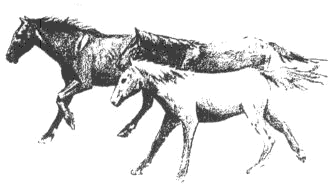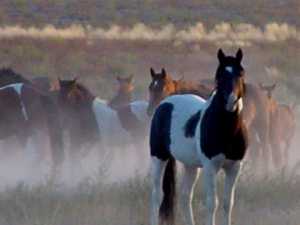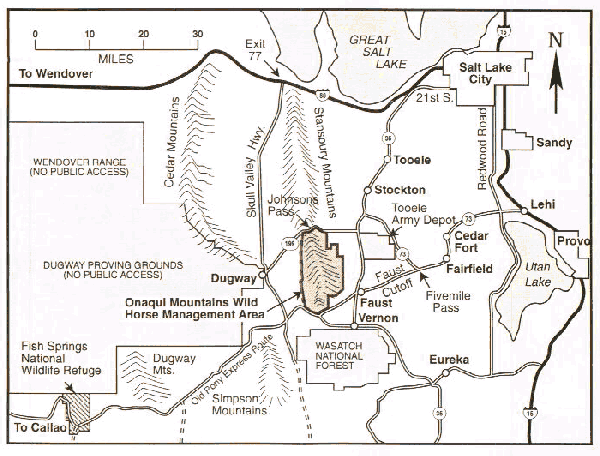|
(Information and graphics courtesy of BLM, Salt Lake District Office)
The Onaqui Herd Management Area (HMA) is located 40 air miles southwest of Salt Lake City. The HMA extends from Johnson's Pass south to Lookout Pass. Wild horses can be seen on the bench and flat areas along the east and west side of the mountain range. The HMA contains 43,880 acres of Federal, State, and privately owned land. The vegetation on the upper elevations of the Onaqui Mountains is comprised of mountain brush and scattered stands of conifers. The foothill area is vegetated by stands of juniper trees. Areas that have burned or have been mechanically revegetated contain bunch grass. The valley areas are comprised of sagebrush and annual cheatgrass. Wild horses have occupied the Onaqul Mountains since the late 1800s. Most of the horses are descendants of horses that escaped from local ranches. 
The dominant colors within the herd area are brown and bay. Other colors found include sorrel, roan, buckskin, black, and white with some pinto sprinkled in. The wild horses on the Onaqul's are classified as below average in size. Although they appear to be larger, a 1991 winter round up discovered the mares to average around 700 pounds and the stallions, around 900. The horses are good to average in composition and generally remain healthy even during periods of drought. A survey in November 1991 counted 169 wild horses in the Onaqui's. Of these, 158 were adults and 11 were foals. 
From Salt Lake City take I-80 west approximately 20 miles to the Lake Point / Tooele exit. Travel south on State Highway 36 through Tooele and Stockton. Turn south on State Highway 199 through Rush Valley and Johnson's Pass to Terra. Turn south at the BLM sign marked "Onaqui Mountains." Horses may be viewed south along this road to Lookout Pass and the Pony Express Trail.
Road conditions along Onaqui Mountains are influenced by moisture. When wet they are slick, and very dusty during extended dry periods. Due to these conditions, the roads remain rough and should be traveled by high profile vehicles. (Check with the Salt Lake District Office at (801) 977-4300 for up to date access and road conditions.) Wild horses are naturally wary. They are best viewed with binoculars at a distance. When approached, they will normally spook and run for cover. To see additional photos of Onaqui wild horses, Click Here.This is not a BLM operated or BLM sponsored site. It is run by private wild horse and burro enthusiasts. We are thankful to the BLM for providing the information which is presented here.
Return to "Wild Horses and Burros in Utah" PageReturn to KBR World of Wild Horses & BurrosGo to other Wild Horse LinksGo To
|
